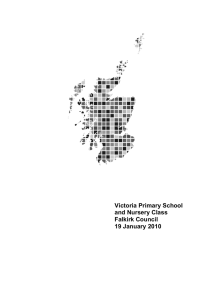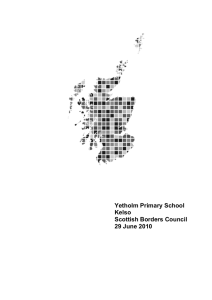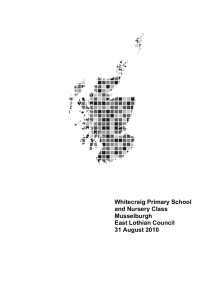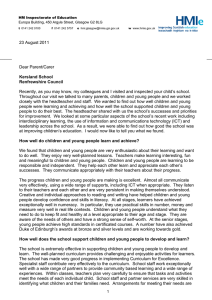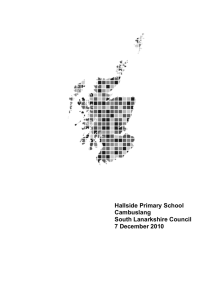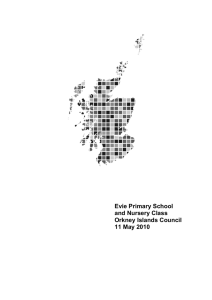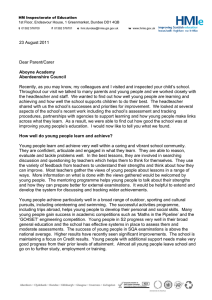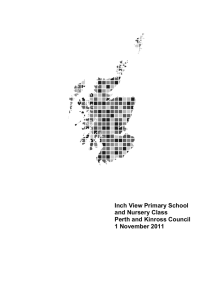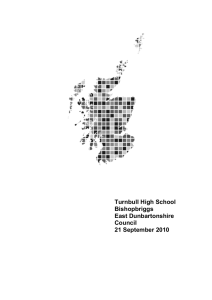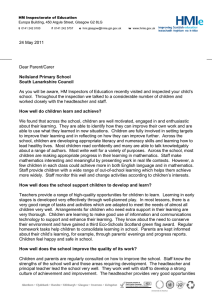Palnackie Primary School Dumfries and Galloway Council
advertisement
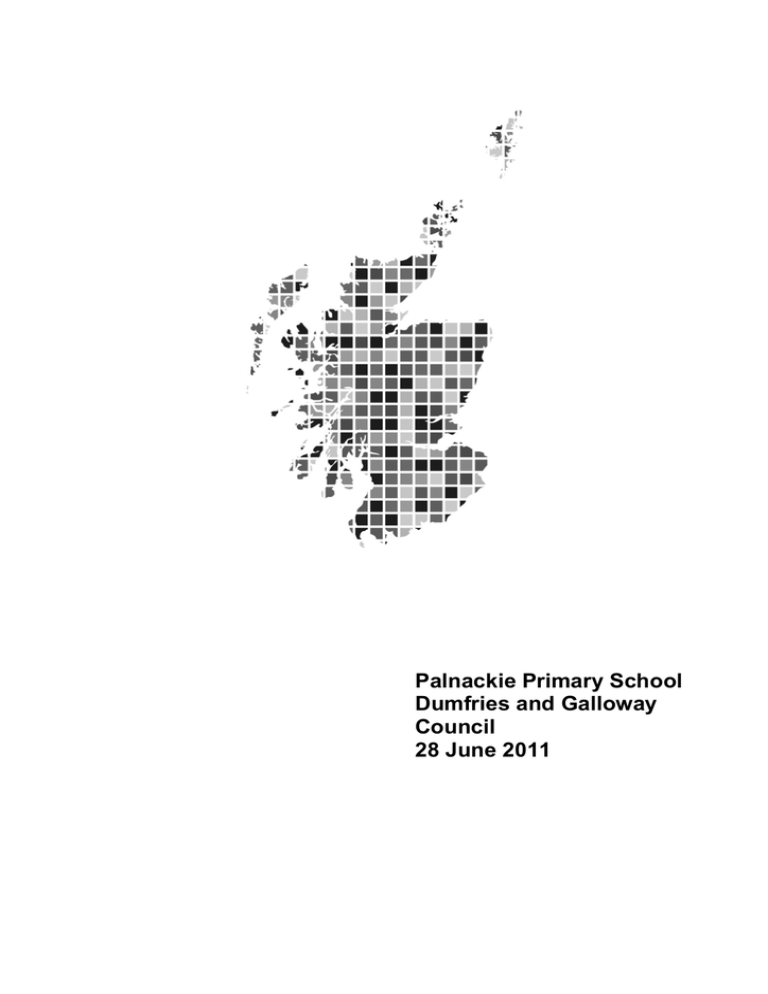
Palnackie Primary School Dumfries and Galloway Council 28 June 2011 HM Inspectorate of Education (HMIE) inspects schools in order to let parents1, children and the local community know whether their school2 provides a good education. Inspectors also discuss with school staff how they can improve the quality of education. At the beginning of the inspection, we ask the headteacher and staff about the strengths of the school, what needs to improve, and how they know. We use the information they give us to help us plan what we are going to look at. During the inspection, we go into classes and join other activities in which children are involved. We also gather the views of children, parents, staff and members of the local community. We find their views very helpful and use them together with the other information we have collected to arrive at our view of the quality of education. This report tells you what we found during the inspection and the quality of education in the school. We describe how well children are doing, how good the school is at helping them to learn and how well it cares for them. We comment on how well staff, parents and children work together and how they go about improving the school. We also comment on how well the school works with other groups in the community, including services which support children. Finally, we focus on how well the school is led and how staff help the school achieve its aims. If you would like to learn more about our inspection of the school, please visit www.hmie.gov.uk. Here you can find analyses of questionnaire returns from children, parents and staff. We will not provide questionnaire analyses where the numbers of returns are so small that they could identify individuals. 1 Throughout this report, the term ‘parents’ should be taken to include foster carers, residential care staff and carers who are relatives or friends. 2 The term ‘school’ includes the nursery class or classes where appropriate. Contents 1. The school 2. Particular strengths of the school 3. How well do children learn and achieve? 4. How well do staff work with others to support children’s learning? 5. Are staff and children actively involved in improving their school community? 6. Does the school have high expectations of all children? 7. Does the school have a clear sense of direction? 8. What happens next? 1. The school Palnackie Primary School is a non-denominational school. It serves the village of Palnackie and surrounding areas. The roll was 20 when the inspection was carried out in May 2011. Children’s attendance was in line with the national average in 2009/2010. The headteacher had been in post for three months at the time of the inspection. 1 2. Particular strengths of the school • The improvements to the school buildings and surrounding areas, and the impact of these on children’s confidence and the environment for learning. • Involvement of parents and community members in the work of the school. • The impact of the headteacher’s leadership on children’s attitude to learning and staff teamwork and morale. 3. How well do children learn and achieve? Learning and achievement Children’s confidence is improving. The majority can work well together and concentrate on their work. They need more regular opportunities to learn independently and in groups. Children enjoy learning in the nearby woods and in their outdoor classroom. In the P1-P4 class, children are benefiting from more active learning tasks. They respond very well to sequencing tasks on how to plant sunflower seeds. In the P5-P7 class, children have started to use, ‘learning logs’ to record what they have been learning. They now need to talk with teachers about their learning and set targets for what they will learn next. Younger children make some good use of information and communications technology to support their learning in art. Children are developing well their awareness of environmental issues. They are proud of their bronze Eco-Schools Scotland award that the reformed eco committee achieved, with the support of a student volunteer. Children work with Forest Schools personnel to learn some survival techniques. They plant vegetables and learn how to safely light a fire to cook food. In recent months, children have benefited 2 from newly-formed after-school clubs where they are improving their social and teamwork skills. The school’s nutrition action group and the catering manager have been successful in improving the dining experience for all. The majority of children attain appropriate levels of attainment in reading and mathematics. Just over half attain these levels in writing. Across the school, most children are capable of achieving higher standards. Children at the early stages who attained these levels earlier than would normally be expected, have not sustained their progress into the middle and upper stages. By upper stages, not all children are fluent enthusiastic readers. Children do not listen well to each other or to instructions from teachers. Their writing needs to improve and presentation is weak. Children at the early stages enjoy mathematical activities which involve them actively in their learning. They used arbitrary units of measurement to weigh bags of birdseed. Older children are gaining confidence in using tally marks. They are learning to use a range of problem solving skills in other areas of the curriculum. Curriculum and meeting learning needs Staff have taken some action to develop the curriculum, taking account of the principles of Curriculum for Excellence. They have worked successfully with other schools to refresh the programmes for literacy and numeracy. As yet, the curriculum does not provide children with at least two hours of high-quality physical education. Their fitness is improving as a result of activities organised by the Active Schools coordinator and visiting teacher of physical education. Very effective contributions from other visiting staff enhance children’s learning in music, art and French. Staff are making increasingly effective use of the school grounds and the local area to support children’s learning. Children are beginning to benefit from a wider range of enterprise activities. The school provides effective pastoral care for children and their families. Support staff provide valued assistance to individuals in 3 class. Staff work well with visiting professionals and agencies to support more vulnerable children. Across the school, the quality of children’s learning is not consistently high. In the best lessons, children are motivated and well-behaved learners. Teachers need to plan better to meet the needs of all learners. Tasks and activities need to be more stimulating, challenging and ensure children learn at a faster pace. In recent months, the arrangements to support children who have difficulty with their learning have been improved. The support for learning teacher has worked closely with the headteacher to identify those children who need extra help with their learning. As a result, children persevere for longer with tasks and achieve greater success in their learning. 4. How well do staff work with others to support children’s learning? Parents like the improvements to the school building, outdoor areas and to the classrooms. They appreciate the improvements made by the headteacher to the way the school shares information with them. A new school website, newsletters and information events have helped parents learn more about what their children are learning in school. The parent council values highly the headteacher’s active involvement in the community council. She has been successful in securing a grant to develop a trim trail in the nearby woodland. The school deals well with the very few complaints it receives. Staff and children work closely with a residential home for the elderly and local business links are improving. Children have entertained residents and make scones and serve afternoon tea for their guests. Transfer arrangements from nursery to P1 need to be improved while those from P7 to Dalbeattie High School are supportive of children and are well organised. Enhanced transitions are in place to support children who require extra support when moving to secondary school. 4 5. Are staff and children actively involved in improving their school community? The headteacher and staff recently carried out a review of the curriculum and the quality of children’s learning. The headteacher has identified significant weaknesses in key aspects of the work of the school. Since taking up her post three months ago, she has successfully improved the environment for learning and aspects of the curriculum. The school did not have in place, arrangements to monitor children’s attainment or progress in learning. The quality of learning and teaching has not been rigorously evaluated. The headteacher has valued the support from the education authority and from other headteachers in the cluster. The pupil council has been re-established and extended to include younger children. Members of the pupil council enjoy having more say in how to make their school better. 6. Does the school have high expectations of all children? The school ethos has improved. Children enjoy coming to school and their relationships with staff are increasingly positive. Staff have made improvements to the systems which reward good behaviour and children’s achievements in and out of school. Most children respond well to these incentives. As a result, behaviour is improving. There is evidence that staff are raising their expectations of what children can achieve. More needs to be done to raise attainment and ensure that there is an ethos of mutual respect. Arrangements for religious observance are appropriate. Staff know how to keep children safe and their responsibility in implementing effectively the school’s child protection policy. 7. Does the school have a clear sense of direction? The headteacher has gained the full support of parents and staff. She has involved the school and its community fully in a review of the vision, values and aims for the school. Once finalised the vision, 5 values and aims statement will support the future direction of the school. The headteacher is highly motivated and has taken effective action to provide the school with a clear direction. She will require the continued support of the education authority if she is to be successful in leading the significant areas for improvement that have been identified. 8. What happens next? We will carry out a follow-through inspection visit within one year of publication of this report and will report to parents on the extent to which the school has improved. Following that visit, we may continue to check the improvements the school has made. We may also carry out a second follow-through inspection within two years of the original inspection report. If a second follow-through inspection visit is necessary then it will result in another report to parents on the extent of improvement that the school has made. We have agreed the following areas for improvement with the school and education authority. • Continue to take forward curriculum development, taking account of Curriculum for Excellence. • Improve attainment in English language and mathematics. • Improve further self-evaluation processes which lead to improvements in achievements, learning, teaching and meeting children’s needs. • Continue to develop a shared vision for the school. 6 Quality indicators help schools and nursery classes, education authorities and inspectors to judge what is good and what needs to be improved in the work of a school and a nursery class. You can find these quality indicators in the HMIE publications How good is our school? and The Child at the Centre. Following the inspection of each school, the Scottish Government gathers evaluations of three important quality indicators to keep track of how well all Scottish schools and nursery classes are doing. Here are the evaluations for Palnackie Primary School. Improvements in performance Learners’ experiences Meeting learning needs weak satisfactory satisfactory We also evaluated the following aspects of the work of the school. The curriculum Improvement through self-evaluation HM Inspector: Marion A Burns 28 June 2011 7 satisfactory weak When we write reports, we use the following word scale so that our readers can see clearly what our judgments mean. excellent very good good means means means satisfactory weak unsatisfactory means means means outstanding, sector leading major strengths important strengths with some areas for improvement strengths just outweigh weaknesses important weaknesses major weaknesses If you would like to find out more about our inspections or get an electronic copy of this report, please go to www.hmie.gov.uk. Please contact us if you want to know how to get the report in a different format, for example, in a translation, or if you wish to comment about any aspect of our inspections. You can contact us at HMIEenquiries@hmie.gsi.gov.uk or write to us at BMCT, HM Inspectorate of Education, Denholm House, Almondvale Business Park, Almondvale Way, Livingston EH54 6GA. Text phone users can contact us on 01506 600 236. This is a service for deaf users. Please do not use this number for voice calls as the line will not connect you to a member of staff. You can find our complaints procedure on our website www.hmie.gov.uk or alternatively you can contact our Complaints Manager, at the address above or by telephoning 01506 600259. Crown Copyright 2011 HM Inspectorate of Education
